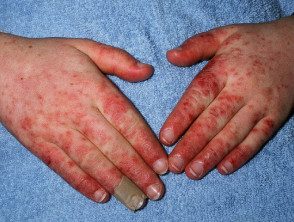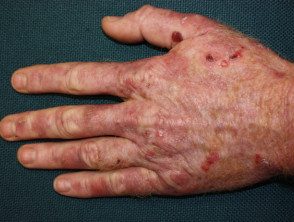What are antimalarial drugs?
Antimalarial drugs are drugs with immunomodulator and antiinflammatory Effects They are used to treat various skin conditions.
Antimalarial drugs used in dermatology include:
- Chloroquine
-
Hydroxychloroquine
-
Quinacrine (mepacrine).
Hydroxychloroquine has largely replaced quinacrine and chloroquine due to its better safety profile. [one].
How do antimalarial drugs work?
The antimalarials are:
- Anti-inflammatory
- Antiproliferative
- Immunomodulator
- Sunscreen
- Weakly antithrombotic (reduce blood clotting).
Anti-inflammatory effects of antimalarials.
Antimalarial drugs reduce the production of cytokines that induce an inflammatory response by activating macrophages, dendritic cellsand lymphocytes where they are trapped inside the cytoplasm lysosomes (enzyme-full organelles that dissolve molecules) [2].
- Lysosomal pH is increased
- Lysosomal protease activity decreases
- The Union of autoantigens to class II major histocompatibility complex (MHC) is reduced
- There is a decrease in toll stimulation receiver (TLR) 9
- TLR 3, 7 and 8 are activated
- There is an increased load of MHC class I antigens.
Antiproliferative and immunomodulatory effects of antimalarials.
The antiproliferative and the immunomodulatory effects are mediated by:
- Diminished lymphocyte proliferation
- Interference with natural killer cell exercise
- Alteration of autoantibody production [2].
- Antimalarials accumulate in the skin to provide a physical photoprotective barrier by absorbing certain wavelengths of light.
- They dampen the usual inflammatory response of keratinocytes to exposure to Ultraviolet radiation [3].
Antimalarial drugs prevent platelet aggregation and act as prostaglandin antagonists due to inhibition phospholipase A2 [3]. It is unclear whether the antithrombotic effect is therapeutically useful. Hydroxychloroquine has been associated with a decrease in 15-20% in serum cholesterol, triglyceridesand low-density lipoprotein levels [1]. Is reduced glucose decreasing insulin degradation resulting in lower levels of glycosylated hemoglobin (HbA1c). It is antiviral, antineoplastic, and can improve bone density.
the pharmacokinetics antimalarial
Chloroquine and hydroxychloroquine are chemically similar and are part of the amino quinoline family.
- Amino quinolines are absorbed mainly in the gastrointestinal tract.
- Peak plasma concentrations are reached in 4 to 12 hours.
- Stable concentrations are reached after 4 to 6 weeks. Patients should be aware that it may take 2-3 months to notice a therapeutic effect.
- About 50% of the drug is excreted through the kidneys. Therefore, dose adjustments should be made in patients with renal disability.
- The drug's 60-70% binds to plasma proteins that are deposited in tissues such as the liver, spleen, kidneys, and lungs.
- There is a great affinity for melanin-contain cells in the skin and retina. the statement of amino quinolines in these cells can lead to toxicity, Resulting in pigmentation changes and retinal toxicity [1].
- For an identical dose of hydroxychloroquine and chloroquine, tissue chloroquine levels are 2.5 times higher than those of hydroxychloroquine. Therefore, chloroquine is more toxic [1].
There is not cross reactivity between 4-aminoquinolines and quinacrine due to differences in chemical structure; therefore a adverse reaction to an aminoquinoline does not prevent the use of quinacrine.
What are antimalarials used for?
Antimalarial drugs are first-line drugs for:
- Lupus erythematosus
-
Porphyria cutanea delays.
They are used as a second line to treat:
- Dermatomyositis
- Disseminated granuloma cancel
- Polymorphous light eruption
-
Sarcoidosis
Antimalarials are sometimes used to treat other inflammatory skin conditions.
Antimalarial-treated disorders

Systemic lupus erythematosus

Cutaneous porphyria delays

Dermatomyositis
Other inflammatory skin conditions treated with antimalarials
Other inflammatory skin conditions treated with antimalarial drugs include:
- Actinic lichen planus
- Actinic prurigo
-
Actinic reticuloid
- Cancel elastolytic giant cell granuloma
-
Antiphospholipid syndrome
- Atopic dermatitis
- Chronic actinic dermatitis
- Chronic erythema knotty
- Cutaneous CD8 + pleomorphic T cell lymphoma
- Eosinophilic fasciitis
- Epidermolysis bullosa
- Erosive lichen planus
- Follicular mucinosis
- Frontal fibrous alopecia
- Graft versus host disease
- Histiocytic necrotizing lymphadenitis (Kikuchi Fujimoto disease)
- Lichen planus
-
Lichen sclerosus
- Lipodermatosclerosis
- Morph
- Necrobiosis lipoidica
- Lattice erythematous mucinosis
- Schnitzler's syndrome
- Solar urticaria
- Systemic sclerosis
- Urticaria
- Urticaria vasculitis
- Nodular panniculitis.
Which are the contraindications with antimalarial drugs?
Antimalarial drugs should not be used in patients with hypersensitivity to pre-existing drug or retinopathy. Care should be taken with children, the elderly, pregnant and lactating women, and patients with severe renal impairment.
Of smoking
Smoking is reported inhibit the P450 enzyme system, decreasing the effectiveness of antimalarial therapy, especially in patients with chloroquine [4] Patients taking antimalarial drugs are recommended not to smoke.
What monitoring is required with antimalarial drugs?
- The patient's complete blood count should be checked monthly for the first three months, then every 4–6 months.
- The patient's kidney function must be verified in base, after one month, after three months, and then every 4-6 months (more frequent surveillance is needed if laboratory values are abnormal or in high-risk patients).
- A pregnancy test should be performed on women of childbearing age.
- There should be a baseline eye exam within the first year of starting therapy. In the absence of the risk factors listed below, the annual evaluation should be done after five years. [5].
Hydroxychloroquine levels can be measured in the blood.
- A standardized therapeutic level has not been validated.
- Levels of> 500 ng / ml indicate adherence to treatment. [4].
- In systemic lupus erythematosus, significant improvement and remission they have been associated with blood levels of> 750 ng / ml.
What are the side effects and risks of antimalarials?
Except for severe retinopathy, the side effects of antimalarial drugs usually resolve when they are stopped.
Ocular side effects
Corneal deposits
- Corneal deposits occur in the 90% of patients with chloroquine and do not occur in patients with hydroxychloroquine; Quinacrine can also cause deposits.
- Corneal deposits are generally asymptomatic, and treatment can continue.
- Patients may experience transient halos and increased sensitivity to light.
- Deposit is dose related, and occurs 4 to 6 weeks after therapy is started.
Retinopathy
Chloroquine and hydroxychloroquine to a lesser extent can cause irreversible retinal toxicity. The cause is believed to be a high affinity for melanin-containing cells in the retina pigment epithelium [one]. The risk of toxicity is dependent in various factors
The main risk factors for retinal toxicity include:
- A daily dose of hydroxychloroquine> 5.0 mg / kg of actual body weight
- A daily dose of chloroquine> 2.3 mg / kg of actual body weight
- Renal insufficiency
- Concomitant tamoxifen treatment
- Pre-existing retinopathy
- A duration of use> 5 years.
Routine examination is essential because early malaria retinopathy does not cause symptoms.
Damage patterns vary by ethnicity.
- Caucasian patients present with ox-eye retinopathy or paracentral scotoma (loss of vision island).
- Patients with Asian heritage present with more peripheral defects
Gastrointestinal adverse effects
Antimalarial drugs may cause transient or persistent nausea, flatulence, vomiting, or diarrhea that resolve with reduction or cessation of medication. Symptoms can be minimized by taking the medication with food.
Cutaneous adverse effects.
Adverse skin effects of antimalarial drugs include:
- Urticaria
- Lichenoid rashes
- Alopecia
- Photosensitivity
- Exfoliative dermatitis
- Centrifugal annular erythema
- A brownish discoloration of the nail bed
-
Pigmentation.
-
Hydroxychloroquine can cause bluish-gray skin depigmentation in sun-exposed areas in ~ 25% of patients receiving long-term therapy [2].
-
Quinacrine causes yellowing of the sclerotic and skin that is not related to liver damage; This discoloration is more prominent in light-skinned patients.
-
Neuropsychological effects
Neuropsychological side effects due to antimalarial drugs are rare and generally occur in patients treated with higher doses than those used in dermatology. Psychosis, irritability, depression, insomnia and nightmares have been reported. Antimalarial drugs are rarely known to induce a seizure in predisposed individuals.
Neuromuscular effects
-
Hydroxychloroquine has been reported to cause proximal myopathy.
-
Chloroquine has been reported to cause neuromyopathy, myalgiaand fatigue
Hematological effects
Hematological side effects are rare with antimalarial drugs. Hemolysis in patients with glucose-6-phosphate dehydrogenase (G6PD) deficiency, aplastic anemiaand leukopenia have been reported but are rare [6]. Detection of G6PD deficiency is not routinely recommended for hydroxychloroquine, but is required for chloroquine.
Pharmacological interactions with antimalarial drugs [2]
Antimalarial drugs can cause various interactions with other drugs. [two].
Antimalarial drugs increase the plasma levels of:
- Digoxin
- Methotrexate
- D-penicillamine
- Cyclosporine
- Beta blockers.
There are synergistic antiarrhythmic effects with chloroquine and amiodarone.
Antimalarials decrease the bioavailability of penicillin.
There is a greater bioavailability of the antimalarial agent with:
- Cimetidine
- Ritonavir
There is decreased bioavailability of the antimalarial agent with:
- Cholestyramine
- Antacids
There is an increased risk of myopathy with antimalarials and:
- Aminoglycosides
-
Corticosteroids
Antimalarial drugs decrease the effect of:
- Neostigmine
- Physostigmine.
Pregnancy and antimalarial drugs.
Antimalarial drugs cross the placenta and are considered category D in pregnancy. Category D implies that they should only be taken during pregnancy if the benefits outweigh the risks. However:
- Hydroxychloroquine has not been associated with congenital defects, stillbirth, prematurity, low birth weight, stillbirth or infant retinopathy.
- Hydroxychloroquine reduces the risk of cardiac manifestations of neonatal lupus in pregnant women with anti-SSA / Ro-positive systemic lupus erythematosus (SLE) [7].
- Hydroxychloroquine is also safe during lactation.
Chloroquine can cause fetal retinopathy and should not be used in pregnancy. [4]. Therefore, hydroxychloroquine is a safer option for women planning a pregnancy or lactation.

